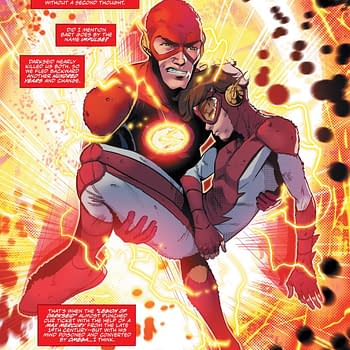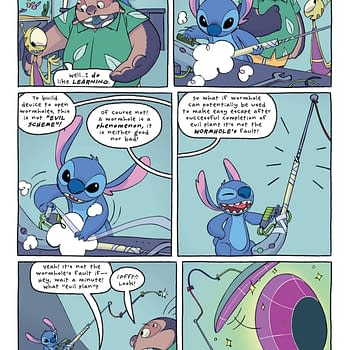Posted in: Comics | Tagged: Batman, Dynamite Entertainment, green arrow, green hornet, grendel, Mage, matt wagner, Mike Raicht
Matt Wagner Talks The History Of The Green Hornet Both In And Out Of Comics
Matt Wagner is one of the few creators who is lauded equally for his writing and his art. His characters of Grendel and Mage are mainstays of independent comics and his cover runs on Batman and Green Arrow are fan favorites. Wagner's run on Green Hornet for Dynamite Entertainment is now being collected and Mike Raicht had a chance to speak to the double-threat creator about the series.
MIKE RAICHT: I just wanted to start by saying that I am a huge fan of Mage, so thank you for creating such an extremely fun world and character. As a creator, do you find yourself approaching your own characters like Grendel and Mage differently than you do your work for hire characters?
MATT WAGNER: I can't really say there's a huge difference in approach. My main concern in all cases is to tell an engaging story and, hopefully, one that has some lasting resonance for the reader. Certainly, in the case of my own creations, I'm the final authority on anything that happens in the narrative. But I also enjoy a pretty free hand with most of the work-for-hire characters I write. Part of that is my place and cachet in the industry at this point in my career. But I also want to give due credit to Dynamite for extending me that freedom as well. They really do try their best to give their creators the most freedom possible when it comes to working on licensed characters.
MR: What drew you initially to starting with this particular Green Hornet: Year One storyline? Was this a time period you always wanted to explore or was it something you only recently became interested in?
MW: Well, part of it was the time period…yes. Anyone who knows my work on Sandman Mystery Theatre knows that I have a real affinity for that era in American history. Plus, I love the atmosphere and trappings of pulp fiction. Even though, technically speaking, The Green Hornet was a radio character; his stories certainly had a pulp-ish vibe to them. I guess I've always had an interest in this time period because my parents were slightly older, of the WWII generation, and so I have a somewhat inherited nostalgia for those times via them. So, when Dynamite was developing The Green Hornet as a legacy character, spanning several different time frames and personas, it only made sense that I'd be drawn to the original, "Golden Age" version of the character.
MR: Is there a specific story or moment in the Green Hornet and Kato's history that you draw on for your take on them?
MW: When it actually came time to work on the Hornet, I was kinda surprised to find that he really didn't have an already-existing origin tale. I say surprising because the character was spawned by the same duo who created The Lone Ranger, George W. Trendle and Fran Striker. In fact, the two characters are supposed to be related (The Hornet is The Ranger's great nephew) and their motifs are nearly identical; both wear a mask and operate outside of the law, both have a specialized weapon, both have a super-fast method of transportation named after a color, both have an ethnic partner/sidekick and both have an odd, up-tempo piece of classical music as their themes songs. Anyway, The Ranger has a very distinct and specific origin that was featured on the radio program and is pretty well known. Not so with The Hornet, who's already established in his role as a crime-fighter (but publicly perceived as a masked villain) from the very beginning of his radio adventures. So, the fact that I would get to define the origins of this iconic character all on my own was a real attraction.
One of the things I wanted to do was re-define Kato's role into more of an active partner in The Hornet's adventures. In the radio version of the narrative, he's really little more than The Hornet's chauffeur and confidant. He doesn't often participate in the actual crime-busting activities, per se. He was really more of a supporting character. That all changed with the 1960s TV version that featured the incredibly magnetic Bruce Lee as Kato. Suddenly, Kato was a much more active character, always at The Hornet's side when confronting bad guys and often at the forefront of every battle. I wanted to push that even a bit further and show Kato as a vital factor in the actual shaping of Britt Reid's masked crusade. So, I started my story by featuring both of them from a very young age and then developing into the men they would eventually become. I knew they had to meet and connect under dire circumstances to form a powerful, battlefield bond and so I chose the Japanese invasion of mainland China in 1937 as the crucible that would forge their partnership.
MR: You've made a career out of working on masked (and sometimes unmasked) vigilantes of some sort or another. What makes Britt special as The Green Hornet? What separates him from the crowd?
MW: Britt's origin isn't spawned from tragedy (unlike The Lone Ranger), which is somewhat unusual in this sort of narrative. Super-heroes origins are most often grounded in tragedy as the impetus for the hero's adventures to begin. But, Britt already has a civic-minded mentality seeded in him by his father who was a crusading journalist. Britt wants to do well by society and strives in everything he does to contribute to the world's betterment. He comes to his masked identity fairly reluctantly, feeling himself pushed into striking back at the criminal elements that threaten his home town in a manner outside of the printed page, the medium with which he's most familiar. Since he's a journalist, it made sense to really explore every particular aspect of The Hornet's origin—writing it as a bit of an exposé. Thus, I started when both he and Kato are quite young. I spend some time getting him to the position where he must consider another alternative for what he wants to achieve and then we see how every motif of the character is developed; how they come up with the idea of masked alter-egos, why he becomes a "green hornet", how they get the secret hideout, how they develop the "Hornet's Sting", how they get the Black Beauty, etc, etc… You can't really take this approach with every character but, again, because of Britt's journalism background, I thought it really worked in this case.
MR: The Green Hornet and Kato have an interesting relationship, as most heroic duos do – what makes this duo special? How do you approach the dynamic between them to their interactions fresh?
MW: Like I said, I wanted Kato to be more of Britt's equal in the narrative. And, in many aspects, Kato is superior to Britt; he's really Britt's mentor in the ways of shadow warfare. Of course, this being the time frame that it is, I also wanted to overcome some of the racial stereotyping and so that also led me to give Kato a much more enhanced role. Again, in this time frame of "proper" American society, Kato has to appear to be Britt's servant but they both know that isn't really the fact. The biggest connection between the two characters is the fact that they share a highly developed sense of honor, duty and morality that they both learned from their respective fathers. These are both good guys and, in the end, that's what makes them a team…and heroes.
MR: Like a lot of Dynamite books, there is a definitive sense of time and place to their titles. I felt like when I was working on Dark Shadows the 70's era became a character all of its own in my effort to write the title. What aspect of the 30's were you most cognizant of bringing forward as you wrote this initial tale?
MW: Well, again, I'd already done quite a bit of work set the 30s—nearly five years, monthly, on SMT. So, it was all fairly easy to slip right back into that vibe again. I'm finding the same sense of ease and familiarity in my writing on The Shadow: Year One for Dynamite as well.
MR: Is this the first time you worked with the amazing Aaron Campbell? What do you feel he brings to the table as an artist and collaborator?
MW: Yeah, this was my first (and, so far, only) collaboration with Aaron and I can't sing his praises enough. He's an incredibly talented and dedicated artist and absolutely managed to bring this entire world to life in such a distinct and believable fashion. He really made the reader feel like they were in the 1930s and yet gave the narrative such a contemporary vitality as well. I particularly loved his version of Kato. As I said earlier, the Bruce Lee version of the character looms large in everyone's mind but Aaron managed to give our Kato his own unique appearance and personality. He's a fabulous artist.
MR: Now that your Year One arc is over, do you feel as if you accomplished everything you set out to do with the character? Do you have any Green Hornet itches you still need to scratch?
MW: No, Year One was my kitchen-sink take on the character. Like I said, I had the opportunity to explore every aspect of the character, introduced all his familiar motifs and established supporting characters, and also left the tale wide open for many more adventures to come at the end. I accomplished everything I set out to do and feel like anything more I could add would be redundant. Time to let other talented writers pilot Britt and Kato through the remainder of their Golden Age adventures…which they've doing quite nicely.
MR: Let's wrap up by telling us a little about your future creative plans at Dynamite and beyond. What can you tell us about work on the horizon for you?
MW: Well, as I mentioned, I've also had the absolute thrill of turning my Year One lens of another of my absolutely favorite vintage characters—The Shadow. Unlike Britt's tale, The Shadow as a character inherently doesn't lend himself to a total exposé type of tale. I feel it's important to maintain a certain sense of mystery in this case and thus keep The Shadow somewhat still hidden in the shadows…while also exploring his origin at the same time. It's a completely different sort of narrative challenge and I am having a blast with it.
Working with The Shadow, in turn, led to my next big project…and the first sequential project I've both written and drawn in almost five years, a cross-over publishing event between Dynamite and Darkhorse and featuring The Shadow going head-to-head against my own character, Grendel. This is one of those dream projects you never dare to dream about as a young creator but…here I am, livin' that dream! GRENDEL VS THE SHADOW should premiere in 2014.
The Green Hornet: Year One Omnibus Vol 1 is a really long title, and available now.
Mike Raicht writes for Dynamite as well with Dark Shadows #23, the final issue in the series, coming out this week.



























